Daintree Rainforest Guide For Visitors
Situated just north of Cairns, Queensland, the Daintree Rainforest is a region of superlatives. At an estimated 180 million years old, it’s the world’s oldest continuous living tropical rainforest and is home to the Eastern Kuku Yalanji people, one of the world’s oldest living cultures. Within a roughly 460 square mile area, you’ll find some of Australia’s rarest species, including tree kangaroos, cassowaries, and spotted-tailed quolls. It’s also the only place in the world where two UNESCO World Heritage-listed sites meet, thanks to the neighboring Great Barrier Reef.
But what gets lost in these marketing slogans is this: The Daintree isn’t just ecologically and culturally significant—it’s also a stunningly beautiful place to visit. You can while away your days watching electric blue Ulysses butterflies flit through the air; swimming under the rainforest canopy through crystal clear cascades; drifting over colorful coral reefs; or digging for mud crabs alongside an Aboriginal guide.
With its authentic cultural tours, innovative culinary offerings, and incredible wildlife experiences, you’ll leave understanding why the Daintree is one of Australia’s most beloved—and truly extraordinary—destinations.
About the Daintree Rainforest
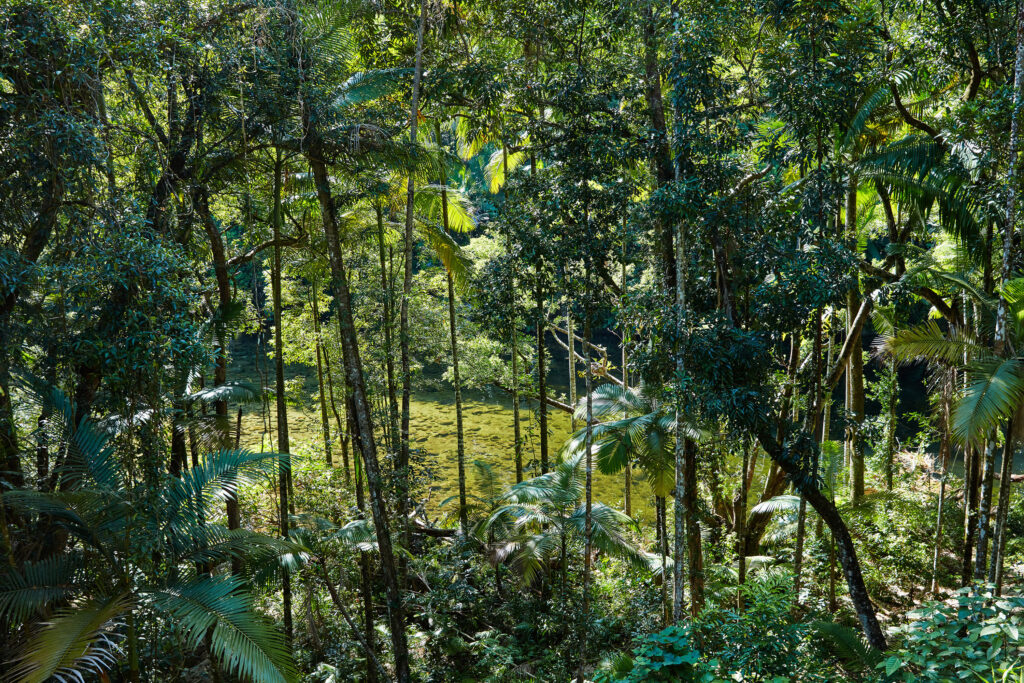
Where is the Daintree Rainforest?
The Daintree Rainforest is a tropical rainforest on the northeast coast of Queensland, Australia, north of Mossman and Cairns.
Daintree Rainforest facts
- The Daintree is the world’s oldest continuously growing tropical rainforest, at an estimated 120 to 180 million years old. That makes it up to 80 million years older than the Amazon rainforest and the closest modern-day counterpart for ancient Gondwana forests.
- The Daintree has greater biodiversity than the Galapagos. It covers an area of less than 0.2per cent of Australia but contains 60per cent of the country’s butterfly species, 40per cent of its bird species, and 30per cent of its marsupial species.
- Much of the Daintree is part of the Wet Tropics of Queensland, a UNESCO World Heritage area. With the Great Barrier Reef right next door, it’s the only place in the world where two UNESCO World Heritage Sites are located side-by-side.
- The Daintree Rainforest receives roughly 10 feet of rain every year, typically between December and April.
Daintree Rainforest animals

The Daintree is known for its remarkable biodiversity and primitive species of plants and animals. Hundreds of bird species have been recorded in the area, with cassowaries being arguably the Daintree’s most famous resident. Head north of the Daintree River to increase your likelihood of seeing one. This is also the stomping ground for rare Bennett’s tree kangaroos, which live high in the canopy. Crocodiles can be found throughout the region but are most frequently spotted along the banks of the Daintree River.
Daintree Rainforest plants
As the oldest rainforest on earth, the Daintree boasts 920 species of trees, along with species of plants that have been in existence since before dinosaurs roamed through Gondwana. Of the world’s 19 primitive flowering plant species, 13 can be found here, including the idiot fruit, one of the rarest plants in the world. Ancient king ferns can also be found, along with 1000-year-old bull kauris, which reach the rainforest canopy at 150 feet tall. (A word of caution: As you explore, take care to avoid the heart-shaped leaves of the stinging “gympie-gympie” tree; accidentally brushing against them can result in months of excruciating pain.)
When to visit the Daintree Rainforest
The Daintree is a year-round destination, with a few key considerations:
Daintree Rainforest climate
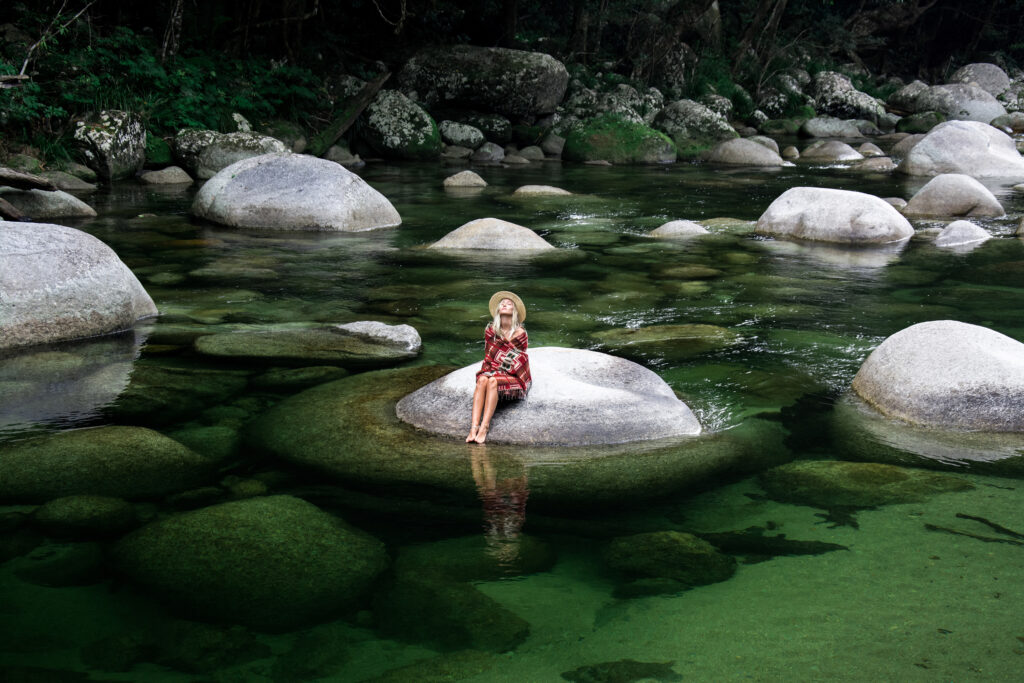
It’s an age-old joke that’s never actually funny: You should expect rain in the rainforest. Tropical North Queensland is named such because during the summertime (roughly October to April) temperatures regularly skyrocket above 85ºF, with accompanying humidity. During the wet season, the area’s many waterfalls rush with fresh rainfall.
If heat isn’t your thing, rest assured that you’ll still be able to comfortably swim during the winter (roughly May through September). Considered the dry season, this is when humidity drops, but daily temperatures still average in the mid-70s.
Wildlife watching and stinger season
If wildlife watching is your priority, it pays to be aware that it can be more difficult—although not impossible—to spot crocodiles between the months of December and April. In addition to nesting during this period, the heat means they’re more likely to stay hidden in the depths of the water in a bid to keep cool.
Cassowaries (giant colorful flightless birds that live in the rainforest) can be seen year-round. But summer is when their chicks hatch, which increases your chances of watching them learn to find fruit under the careful tutelage of their dads, who care for the young.
Finally, if a visit to the Great Barrier Reef is on your itinerary—and it should be—“stinger season” (when jellyfish congregate in high numbers, elevating the risk of being stung) runs from October to May. However, most dive and snorkel companies require that guests wear provided “stinger suits” as a precaution year-round anyway. This also doesn’t affect your ability to swim at the beach since this is also off-limits year-round, thanks to crocs.
School holidays
Australians love exploring their own backyard, so the Daintree gets significantly busier during the school holidays. Peak season is December and January during the summer holidays, but there are also two-week breaks throughout the year, typically in April, July, and September.
How to get to the Daintree Rainforest
Cairns Airport is the regional hub for Tropical North Queensland, and the closest airport to the Daintree. It’s serviced by international, local and regional airlines, including Qantas, Virgin Australia, Air New Zealand and Singapore Air.
How to navigate the Daintree Rainforest
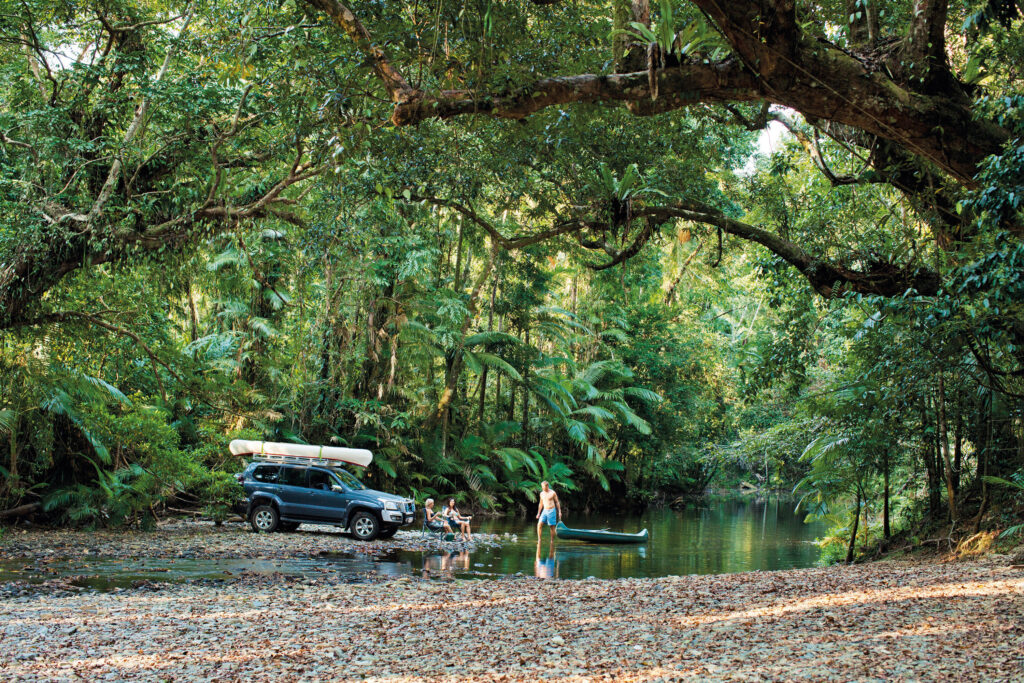
One of the country’s best road trips, the paved roads of the Daintree wind northward along Australia’s east coast and through the rainforest. Apart from Daintree National Park, the exact boundaries of the Daintree aren’t precisely defined, but most would agree that the first major entry point is the Mossman Gorge, just outside the town of Mossman.
The seaside resort town of Port Douglas isn’t technically in the Daintree, but it’s become the default destination thanks to its proximity (it’s about 20 minutes from Mossman) and range of hotels and restaurants.
Meanwhile, Cape Tribulation (about three hours north of Cairns and roughly 90 minutes north of Port Douglas) is the place for a more remote and back-to-nature setting. To access Cape Tribulation, visitors must take a car ferry across the Daintree River, which runs continuously from 5am to midnight. However, queues for the 15-minute crossing can be long during peak periods. For journeys north of Cape Tribulation village, a 4WD vehicle is needed to navigate the unsealed roads, which have steep grades and deep creek crossings.
Alternatively, it is possible to visit the Daintree on a private tour departing from Cairns or Port Douglas.
How long to visit the Daintree Rainforest?
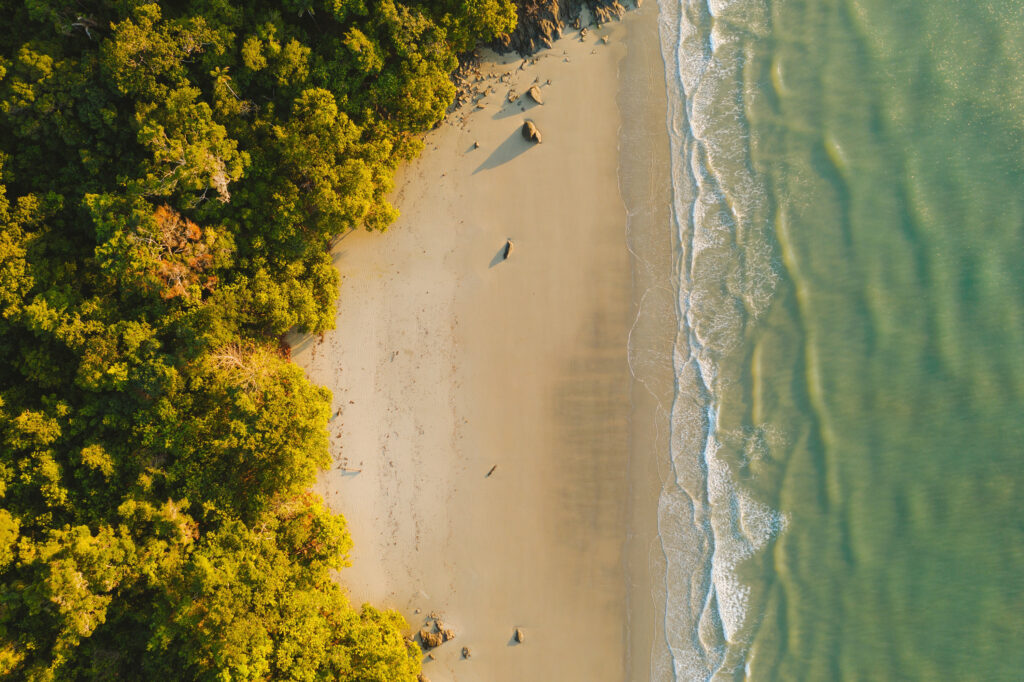
The resort town of Port Douglas—a major gateway to both the Daintree and the Great Barrier Reef—is just over an hour’s drive north of Cairns, making it entirely possible to visit the region on a day trip. But to do so means potentially missing out on aspects of the Daintree’s ecology, rich culture, and rare wildlife.
At a minimum, we recommend spending two nights either in Port Douglas, Mossman, or surrounds. This affords enough time to do a tour of the Mossman Gorge within the Daintree Rainforest, as well as a day trip to the Outer Great Barrier Reef. However, if you want to see crocs or cassowaries, you’ll need to head further north to Cape Tribulation. The off-the-grid destination is synonymous with wildlife, lush rainforest, and unspoiled beaches—but it can only be accessed via a car ferry, which necessitates an extra night or two.
About Daintree National Park
The formal boundaries of Daintree National Park, located within the wider Daintree rainforest area, comprises two sections: Mossman Gorge and Cape Tribulation. In 2021, the park was formally handed back to the traditional landowners, the Eastern Kuku Yalanji people, who manage the area in partnership with the Queensland government.
The official visitor center for the Daintree is the Mossman Gorge Centre. Like most other national parks in Australia, there are no entry fees. However, there is a charge for shuttles buses into the Mossman Gorge. (Visitors on foot or bike can enter for free.) As this is a remote area, mobile reception may be limited or non-existent, particularly in Cape Tribulation.
For maps, camping areas, and trail systems, visit Queensland Parks.
What to do : Daintree Rainforest tours
Walk through the rainforest with a Kuku Yalanji guide
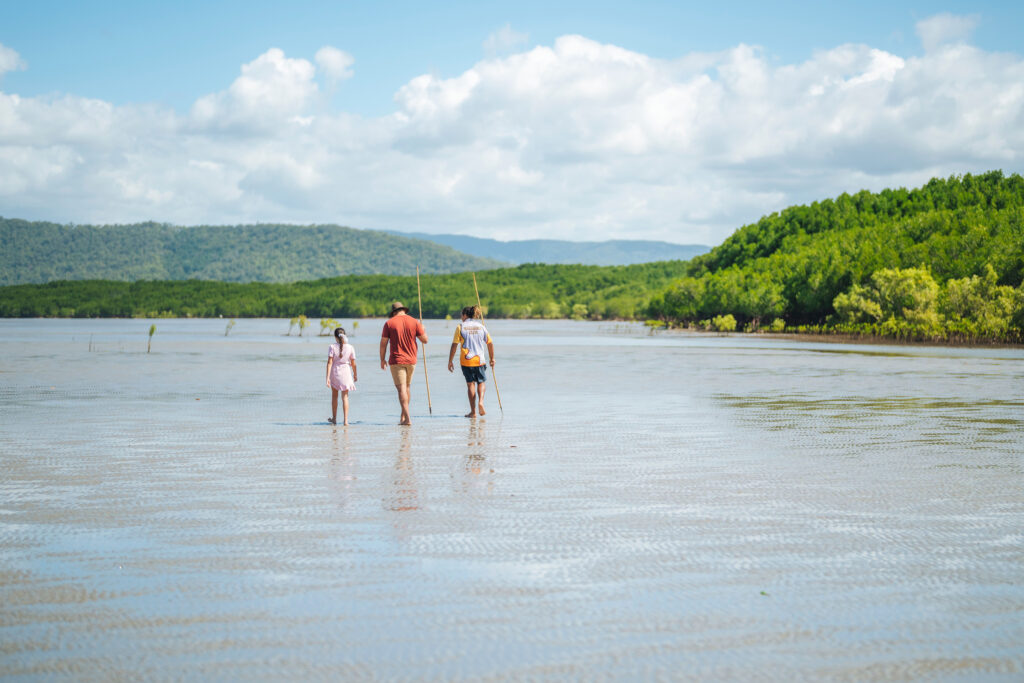
The starting point for any visit to the Daintree should be the Mossman Gorge Centre, where a Dreamtime Walk will provide you with an introduction to the culture and history of the Kuku Yalanji people. Over 90 minutes, an Indigenous guide will lead you through a smoking ceremony and introduce you to the native bush food and medicine that can be found in the rainforest.
If you’re looking for a more immersive experience, sign-up for a half or full-day excursion with Walkabout Cultural Adventures, a First Nations-owned company. In addition to a guided walk along the Mossman Gorge, where you’ll sample bush foods, you can try your hand at digging for mud crab, throwing a spear and a boomerang, or collecting shellfish.
Those looking to go even deeper—both in terms of cultural engagement and into the rainforest—can take a helicopter tour into a remote section of the Daintree. After a 30-minute flight over the tree canopy, you’ll meet Kuku Yalangji Elder CJ, who will share his life story and traditional knowledge of the land alongside a fresh barramundi lunch. The experience is capped off with Back Country Bliss’ trademark River Drift Snorkeling Tours on the croc-free Mossman River. The fun yet serene experience includes bobbing over rapids, snorkeling for freshwater fish, and gently floating on a raft beneath the rainforest canopy.
Take a crocodile cruise

Save for crystal clear waterways like the Mossman River, the streams and oceans of the Daintree are unsafe to swim or even wade in, thanks to the resident crocodiles. You can learn more about their habitat and behavior on a guided crocodile cruise on the Daintree River. Several operators depart from near the car ferry, but one of our favorites is Solar Whisper, the river’s only zero-emissions operator. The electric boat not only benefits the environment, it’s also deadly silent, allowing you to get that much closer to crocodiles and other wildlife, including birds, snakes, and frogs.
Birders and photographers, however, may prefer a guided sunrise and sunset bird-watching tours. Nature guide Murray Hunt will help you get the best shot of the river’s unique wildlife aboard a hybrid vessel.
Snorkel on the Great Barrier Reef
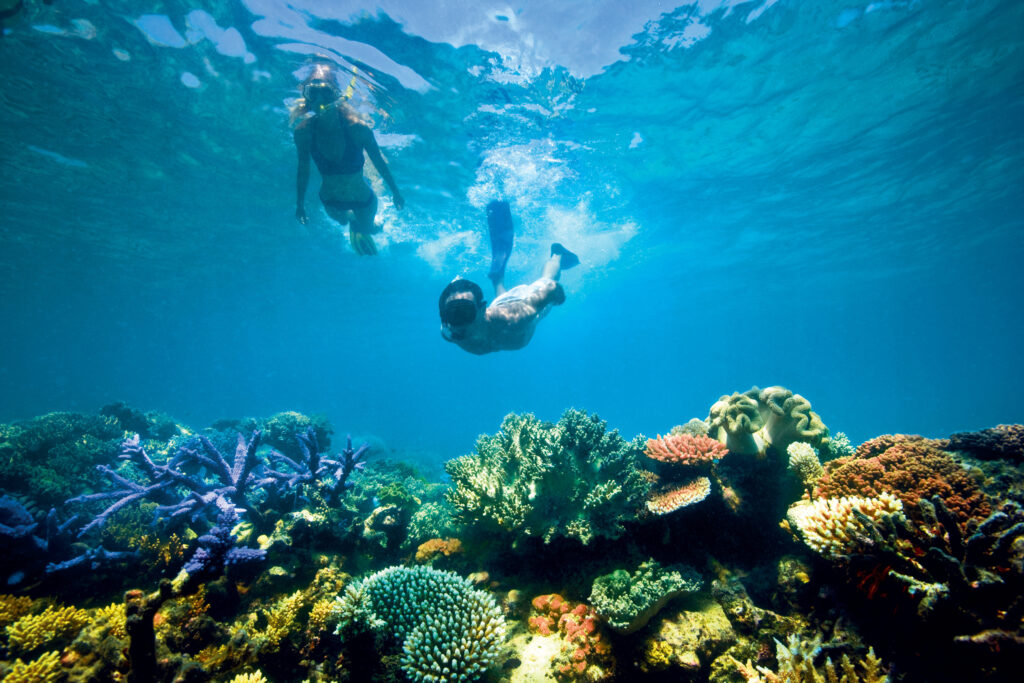
The Daintree is one of the best jumping-off points for snorkeling or diving on the Great Barrier Reef. Port Douglas is situated closer to the Outer Reef than Cairns, with smaller boats and less crowded snorkeling sites. On a luxury catamaran, for example, you’ll be just part of a small group exploring the coral cays of the Mackay Reef, where you’ll swim alongside turtles, over giant clams, and alongside schools of colorful fish. On-board marine biologists will help you identify what you’re seeing before you sail back to Port Douglas in the setting sun with a glass of bubbly in hand.
Where to stay
Silky Oaks Lodge
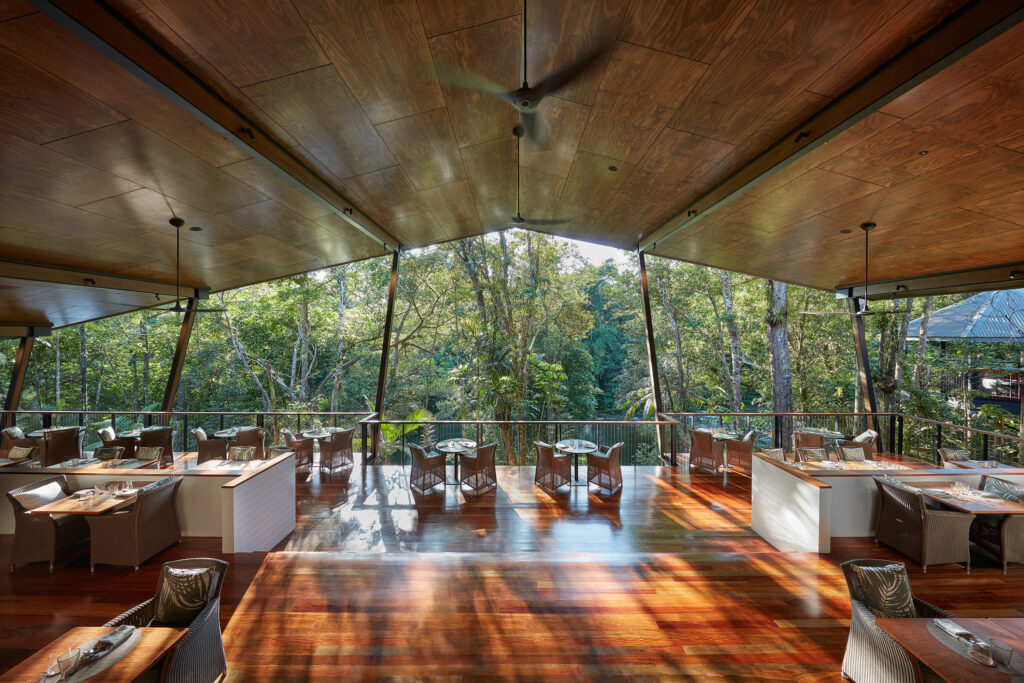
Silky Oaks Lodge has long been one of the most coveted destinations in the Daintree region—but its recent purchase and AUD$20 million refurbishment by Baillie Lodges has elevated it to the next level. The new owners have kept the lodge’s most beloved features (including the hammocks, which can be found outside each room) while taking everything else up a notch. The main lodge is now more fully enveloped in its rainforest setting, with an open-air restaurant that looks out onto the Mossman River below. Meanwhile, the individual treehouses now boast luxe outdoor soaker tubs and outdoor fireplaces, while the brand-new two-bedroom Daintree Pavilion features its own pool and open-air lounging area.
Guests can spend their lounging days poolside, swimming at private beaches on the Mossman River, or exploring the surrounding region, with a range of excursions such as expeditions to the Great Barrier Reef, Aboriginal-led rainforest tours, helicopter flights to hidden waterfalls, and art workshops. Stays at Silky Oaks are all-inclusive, including morning yoga, breakfast, evening cocktails and canapes, shuttle services, and multi-course dinners with wine pairings. explore our Daintree Rainforest Guide for more information.
Further afield: Thala Beach Nature Reserve

Roughly a 30-minute drive south of the Mossman Gorge, this accommodation is much-loved for its natural setting. The family-owned retreat is situated within 145 private acres adjacent to the secluded Oak Beach. The privately situated suites and bungalows are nestled within the native forest, but it’s the on-site experiences—such as star gazing tours and guided talks from local experts—that set this family-friendly accommodation above. Learn more about the Daintree Rainforest here.
Where to eat
With its tropical climate, the Daintree produces a bounty of fresh seafood (including barramundi and tiger prawns), exotic fruits (such as sapote and soursop) and “bush tucker” or wild foods (including Davidson’s plums, green ants, and mud crabs).
The region’s best restaurants combine these three elements, often with Asian cooking techniques, resulting in dishes that are intrinsically connected to the place. There aren’t many restaurants directly in the Daintree—most are in Port Douglas.
Nautilus
Nautilus has been the restaurant of choice for visiting dignitaries for over 65 years. But this open-air dining destination isn’t trapped in time. Instead, head here for the contemporary and seasonal degustation menus featuring fresh seafood and local produce. Most dietary restrictions are catered for (vegetarian, pescatarian, seafood-free, and gluten-free menus are available) if arranged in advance.
Zinc
“Modern Australian” is a culinary term that may seem difficult to define, but Zinc’s menu encapsulates it well. Here, food is cooked over a custom-built grill fueled by native hardwoods and local charcoal, which enhances the flavors of the region’s best seafood and produce. Expect dishes such as sticky pork belly, barramundi in a coconut curry, or pork loin from the nearby Atherton Tablelands. Gluten-free, vegetarian, and vegan options are available.
Harrisons
Harrisons may be situated within the Sheraton Grand Mirage Resort, but it’s not your standard hotel restaurant. This Port Douglas mainstay is the town’s most nationally awarded restaurant, with chef Spencer Patrick (who has worked at Michelin-starred restaurants) and his wife, Reina Patrick, at the helm. Beautifully plated meals include lamb shoulder with cucumber and mint, north Queensland squid spaghetti, and scallops with fried seaweed.
La Cucina + Bar
If you’re stuffed to capacity on seafood—or want your seafood with a side of pasta – La Cucina is a modern Italian restaurant where you can order everything from a traditional pizza to locally caught prawns. Don’t miss La Cucina’s famous spaghetti, which comes served with chili mud crab.
Port Douglas Markets
While not a restaurant as such, it would be remiss not to mention the Port Douglas Markets, where hundreds of vendors gather on the waterfront every Sunday. One of the best markets in north Queensland, this is where you’ll find locally-grown produce, refreshing juices and smoothies, freshly baked goods, coffee, and food truck treats.
The Treehouse Restaurant
Guests go to Silky Oaks for the surrounds (hidden in the rainforest, from the restaurant, you can hear the sound of the Mossman River running below) but leave raving about the food. Fortunately, you don’t have to be staying at the lodge to experience the meals that chef Mark Godbeer creates from the on-site kitchen garden. The Treehouse Restaurant is open to non-guests from noon until 2:30 pm daily (bookings are essential). Menus change seasonally, but you can expect shared dishes heavily influenced by Asian flavors and ingredients, such as kingfish tataki, tempura reef fish, and tropical sorbets.
WHET & Daintree Fan Palm Farm
Once you cross the Daintree River into Cape Tribulation, dining options thin out considerably (just over 100 people live here). For lunch or a casual dinner, head to WHET. Set beside the beach and surrounded by the rainforest, this is the spot to order fresh fish and chips (made with pan-fried barramundi) or a vegetarian Buddha bowl. Given the restaurant’s remote location, bookings are essential.
Looking to stock up on snacks for your road trip? Swing by the Daintree Fan Palm Farm for supplies. In addition to serving coffee and simple snacks (such as savory hand pies and sausage rolls), the organic food store sells fresh produce, dried goods, and local dairy products. An on-site boardwalk provides access to ancient trees, giant fan palms, and a seasonal swimming hole.
Plan your Trip
Ready to start planning your own incredible adventure? We make the process stress-free and enjoyable.
